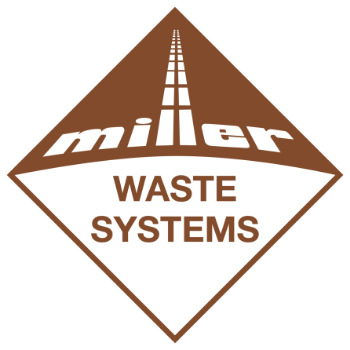When left to decompose in an environment with the right levels of moisture, heat, and oxygen, micro-organisms will break down leaf and yard waste into finished compost – a substance that plants can use as food.
For most, once leaf waste is out of sight, it’s out of mind. However, did you know that the leaves you discard in the fall become the fuel that helps your trees sprout fresh, new leaves come spring?
This is the circular economy in action. In this model, nothing is wasted, and valuable resources find new life as new and useful products. When it decomposes in the right environment, leaf and yard waste becomes finished compost that can be applied to gardens as food for new plant growth.
Known as aerobic (with oxygen) composting, this process occurs very slowly in nature but can be achieved at scale in just a few weeks at composting facilities. This is ideal for the large volumes of leaf and waste generated by municipalities.

At Miller’s composting facilities, we receive leaf and yard waste and create the ideal environment for microbes to break down organic matter into finished compost.
How does leaf and yard waste become useable food for plants?
First, waste management companies like Miller Waste collected residents’ leaf and yard waste separately from their food waste, recycling, and garbage. Leaf and yard waste often includes:
- Leaves and yard rakings with debris
- Tree trimmings and branches
- Brush and hedge trimmings
- Household and garden plants
- Halloween pumpkins
Miller hauls the material to our composting facilities and receives additional leaf and yard waste from other sources. High-speed grinders shred the material into smaller particle sizes, which are then formed into piles known as windrows.

Miller arranges the ground leaf and yard waste into uniform piles where micro-organisms break the matter down
We can think of these as self-contained ecosystems. The windrows are teeming with microbes that, like any other living organism, require specific levels of heat, water, oxygen, and food to survive and multiply. It is their metabolic activity that strengthens the nutritional profile of the ground waste and transforms it into potent fertilizer.
The active composting stage begins with mesophilic bacteria that feed on organic compounds in the ground waste, such as carbon, nitrogen, sugars, and amino acids. As they become more active, they generate heat, causing thermophilic (heat-loving) bacteria and fungi to emerge. Their metabolic activity raises the temperature of the windrow to its peak and inactivates pathogens and weed seeds.
Temperatures above a certain level will also destroy beneficial bacteria and fungi, which is why compost staff regulate the temperature by watering and turning the windrow. Water also helps bacteria move through the pile.

Windrows are turned and watered regularly to adjust heat and humidity levels so new kinds of micro-organisms can emerge.
The active composting stage is followed by the curing stage, during which temperatures drop and another group of thermophilic fungi starts to grow. They break down tough plant tissue, regulate the carbon/nitrogen ratio and add new and diverse minerals to the pile.
The variations in temperature allow a wide variety of bacteria and fungi to emerge in the windrows. The more highly varied the microbes are, the greater the variety of nutrients in the finished compost product will be.
Eventually, the temperature declines further and the material becomes loose, crumbly, and spongy in texture. Cured compost not only contains nutrients that are essential to plant growth, including nitrogen, phosphorous, sulfur, calcium, magnesium, and potassium, but its structure helps soil deliver water and oxygen to plant roots and increases its resistance to drought and erosion.
Once cured, the windrows are removed and screened to produce different sizes of finished compost. Miller’s standard compost is pushed through a ½” screen and the premium compost is screened through a ¼” screen. The smaller the particle size, the easier the compost is to till into soil.

Customers can order finished compost products directly from Miller for pick-up or delivery.
Once applied to soil, compost will not only supply plant roots with nutrients, water, and oxygen, but will continue to break down other organic components in the soil to increase the total supply of nutrients.
Composting returns the value of organic matter to the earth in a closed-loop system – meaning it does not produce waste. Visit the Miller Compost site to order compost and other soil amendment products for your garden and watch as this year’s waste becomes the foundation of next year’s garden!
